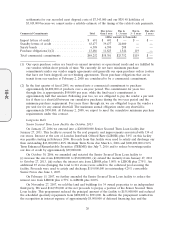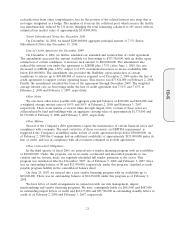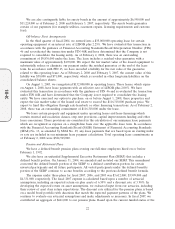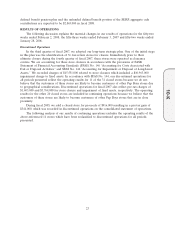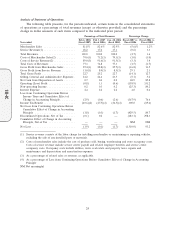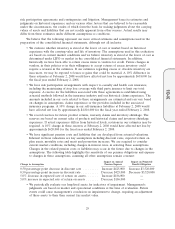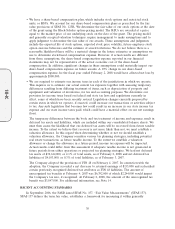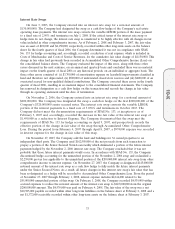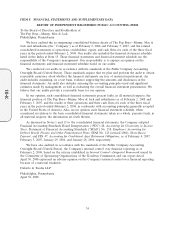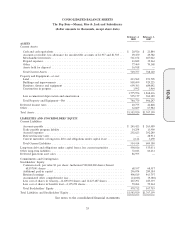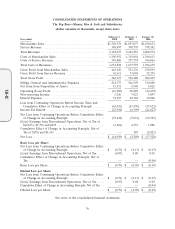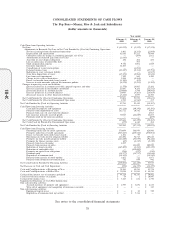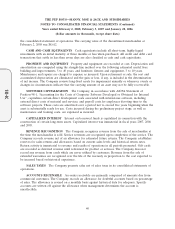Pep Boys 2007 Annual Report Download - page 76
Download and view the complete annual report
Please find page 76 of the 2007 Pep Boys annual report below. You can navigate through the pages in the report by either clicking on the pages listed below, or by using the keyword search tool below to find specific information within the annual report.
• We have a share-based compensation plan, which includes stock options and restricted stock
units, or RSUs. We account for our share-based compensation plans as prescribed by the fair
value provisions of SFAS No. 123R. We determine the fair value of our stock options at the date
of the grant using the Black-Scholes option-pricing model. The RSUs are awarded at a price
equal to the market price of our underlying stock on the date of the grant. The pricing model
and generally accepted valuation techniques require management to make assumptions and to
apply judgment to determine the fair value of our awards. These assumptions and judgments
include the expected life of stock options, expected stock price volatility, future employee stock
option exercise behaviors and the estimate of award forfeitures. We do not believe there is a
reasonable likelihood there will be a material change in the future estimates or assumptions we
use to determine stock-based compensation expense. However, if actual results are different
from these assumptions, the share-based compensation expense reported in our financial
statements may not be representative of the actual economic cost of the share-based
compensation. In addition, significant changes in these assumptions could materially impact our
share-based compensation expense on future awards. A 10% change in our share-based
compensation expense for the fiscal year ended February 2, 2008 would have affected net loss by
approximately $580,000.
• We are required to estimate our income taxes in each of the jurisdictions in which we operate.
This requires us to estimate our actual current tax exposure together with assessing temporary
differences resulting from differing treatment of items, such as depreciation of property and
equipment and valuation of inventories, for tax and accounting purposes. We determine our
provision for income taxes based on federal and state tax laws and regulations currently in
effect, some of which have been recently revised. Legislation changes currently proposed by
certain states in which we operate, if enacted, could increase our transactions or activities subject
to tax. Any such legislation that becomes law could result in an increase in our state income tax
expense and our state income taxes paid, which could have a material effect on our net earnings
(loss).
The temporary differences between the book and tax treatment of income and expenses result in
deferred tax assets and liabilities, which are included within our consolidated balance sheets. We
must then assess the likelihood that our deferred tax assets will be recovered from future taxable
income. To the extent we believe that recovery is not more likely than not, we must establish a
valuation allowance. In this regard when determining whether or not we should establish a
valuation allowance, the Company considers various tax planning strategies, including potential
real estate transactions, as future taxable income. To the extent we establish a valuation
allowance or change the allowance in a future period, income tax expense will be impacted.
Actual results could differ from this assessment if adequate taxable income is not generated in
future periods from either operations or projected tax planning strategies. We had net deferred
tax assets of $32,612,000, or 2.1% of total assets, as of February 2, 2008 and net deferred tax
liabilities of $4,103,000, or 0.3% of total liabilities, as of February 3, 2007.
The Company adopted the provisions of FIN 48 on February 4, 2007. In connection with the
adoption, the Company recorded a net decrease to retained earnings of $155,000 and reclassified
certain previously recognized deferred tax attributes as FIN 48 liabilities. The amount of
unrecognized tax benefits at February 4, 2007 was $6,392,000 of which $2,244,000 would impact
the Company’s tax rate, if recognized. At February 2, 2008, the amount of the unrecognized tax
benefit was $3,847,000. For additional information, see Note 14.
RECENT ACCOUNTING STANDARDS
In September 2006, the FASB issued SFAS No. 157, ‘‘Fair Value Measurements’’ (SFAS 157).
SFAS 157 defines the term fair value, establishes a framework for measuring it within generally
30
10-K


